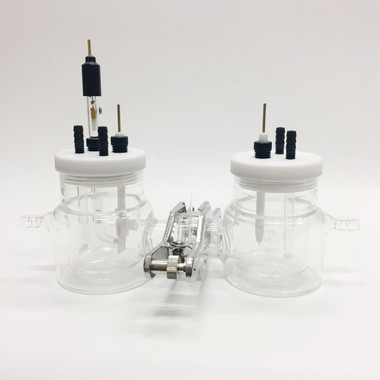H type electrochemical cell includes H-type replaceable ion-exchange membrane electrolytic cell and H-type glass filter element electrolytic cell. The H-type replaceable ion-exchange membrane electrolyzer is a double-chamber three-electrode electrochemical reaction cell, which is suitable for electrochemical experimental tests where the anode and cathode electrolytes are different or not suitable for mixing. For example, CO2RR, NRR and other tests. If the measurement needs to be carried out in a certain gas atmosphere or an oxygen-free environment, a sealed electrolytic cell must be used and equipped with air inlet and outlet pipes.
The H-type replaceable ion-exchange membrane electrolyzer is composed of a working electrode chamber and a counter electrode chamber. The two chambers are separated by ion-exchange membranes (provided by the user), and stainless steel clips are used for rapid membrane change. The reference electrode and the working electrode are in the same chamber, which effectively reduces the R drop. The electrochemical cell can be quickly assembled and disassembled for easy cleaning. The lower glass tank body can also be customized into a double-jacketed glass type according to the temperature control requirements. It is connected to the outer tank body through the hose of a peristaltic pump or a circulating pump. The liquid circulates in the glass jacket layer, relying on heat and cold. Exchange to achieve the effect of cooling or heating the electrolyte solution.


Comments
Post a Comment